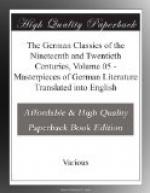Who can say that Winckelmann had not penetrated into the highest beauty? But with him it appeared in its dissevered elements only: on the one side as beauty in idea, and flowing out from the soul; on the other, as beauty of forms.
But what is the efficient link that connects the two? Or by what power is the soul created together with the body, at once and as if with one breath? If this lies not within the power of Art, as of Nature, then it can create nothing whatever. This vital connecting link, Winckelmann did not determine; he did not teach how, from the idea, forms can be produced. Thus Art went over to that method which we would call the retrograde, since it strives from the form to come at the essence. But not thus is the Unlimited reached; it is not attainable by mere enhancement of the Limited. Hence, such works as have had their beginning in form, with all elaborateness on that side, show, in token of their origin, an incurable want at the very point where we expect the consummate, the essential, the final. The miracle by which the Limited should be raised to the Unlimited, the human become divine, is wanting; the magic circle is drawn, but the spirit that it should inclose, appears not, being disobedient to the call of him who thought a creation possible through mere form.
* * * * *
Nature meets us everywhere, at first with reserve, and in form more or less severe. She is like that quiet and serious beauty, that excites not attention by noisy advertisement, nor attracts the vulgar gaze.
How can we, as it were, spiritually melt this apparently rigid form, so that the pure energy of things may flow together with the force of our spirit and both become one united mold? We must transcend Form, in order to gain it again as intelligible, living, and truly felt. Consider the most beautiful forms; what remains behind after you have abstracted from them the creative principle within? Nothing but mere unessential qualities, such as extension and the relations of space. Does the fact that one portion of matter exists near another, and distinct from it, contribute anything to its inner essence? or does it not rather contribute nothing? Evidently the latter. It is not mere contiguous existence, but the manner of it, that makes form; and this can be determined only by a positive force, which is even opposed to separateness, and subordinates the manifoldness of the parts to the unity of one idea—from the force that works in the crystal to the force which, comparable to a gentle magnetic current, gives to the particles of matter in the human form that position and arrangement among themselves, through which the idea, the essential unity and beauty, can become visible.




